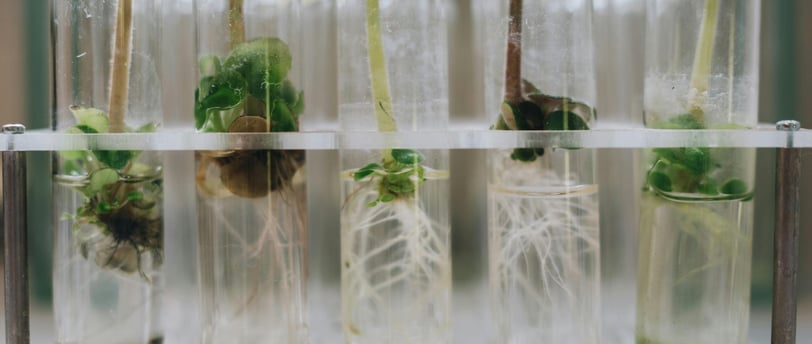What is Propagation, and How Do I Do It?
Propagation is an enjoyable, rewarding way to expand your plant collection or share your plants with friends. With the right techniques and a little patience, you can successfully propagate a wide variety of plants. So, the next time you prune your pothos or admire your spider plant, consider taking a cutting and starting a new plant!
BeginnerPlants
11/9/20243 min read


What is Propagation, and How Do I Do It?
Plant propagation is a simple yet powerful technique that lets you grow new plants from cuttings, seeds, or other parts of your existing plants. Whether you’re looking to expand your indoor jungle or gift a friend a piece of your favorite plant, propagation is an easy and affordable way to multiply your greenery. Let’s dive into what propagation is, why it’s beneficial, and how you can start propagating your plants today!
What is Plant Propagation?
Plant propagation is the process of creating new plants from an existing plant. This can be done through various methods, such as rooting cuttings in water or soil, using plant divisions, or even propagating from seeds. Essentially, you’re using parts of the plant, like stems or leaves, to grow a new one. The best part? You don’t need expensive tools or a green thumb to get started.
Why Should You Propagate Plants?
Propagation isn’t just about multiplying plants; it’s also a sustainable and economical way to garden. By propagating your plants:
• You save money on new plants.
• It’s eco-friendly, as you’re reducing the demand for commercially grown plants.
• It’s a fun and rewarding experience to see a new plant grow from a tiny cutting.
• Gift potential: Propagated plants make thoughtful, unique gifts!
Different Types of Plant Propagation
There are a few common types of propagation, each suited for different plants:
1. Stem Cuttings – Ideal for plants like pothos, spider plants, and philodendrons.
2. Leaf Cuttings – Used for succulents and begonias.
3. Division – Great for plants with multiple crowns or clumps, like ferns or peace lilies.
4. Seed Propagation – Suitable for growing new plants from scratch.
Each method has its advantages, so let’s explore which one might be best for your plants.
How to Propagate Plants at Home
1. Water Propagation
Water propagation is a beginner-friendly way to start. Here’s how:
• Step 1: Cut a healthy stem just below a node (where the leaves and stem join).
• Step 2: Place the cutting in a clear glass of water, making sure the node is submerged.
• Step 3: Place the glass in indirect sunlight and change the water every few days.
• Step 4: Roots should appear in 1-3 weeks, depending on the plant.
2. Soil Propagation
For soil propagation, follow these steps:
• Step 1: Dip the cutting in rooting hormone to encourage root growth.
• Step 2: Plant the cutting directly in moist, well-draining soil.
• Step 3: Keep the soil damp and place the pot in indirect light.
• Step 4: After a few weeks, gently tug on the cutting. Resistance indicates root growth.
3. Leaf and Stem Cuttings
Leaf and stem cuttings are popular for succulents:
• Step 1: Twist off a healthy leaf from the base of the plant.
• Step 2: Let it sit out for a day or two to form a callus.
• Step 3: Place it on top of dry soil and mist it every few days.
• Step 4: Tiny roots and shoots should appear in a few weeks.
Best Plants for Beginner Propagation
If you’re new to propagation, these plants are easy to propagate and quick to root:
• Pothos
• Philodendron
• Succulents like jade and echeveria
These plants respond well to water and soil propagation, making them perfect for beginners.
Common Questions About Propagation
How long does it take to propagate a plant?
On average, it takes 2-4 weeks for roots to develop, but it depends on the plant type and method.
Do I need special equipment?
Not at all! Most propagation requires just a clean pair of scissors, a container, and water or soil.
When should I repot the propagated plant?
Once the roots are 2-3 inches long, they’re ready to be transferred to soil for more stable growth.
Troubleshooting: Why Isn’t My Cutting Rooting?
Sometimes propagation can be tricky. If your cutting isn’t rooting, consider these factors:
• Light: Ensure your cutting is in indirect sunlight.
• Humidity: Low humidity can slow rooting; try covering the cutting with a clear plastic bag to trap humidity.
• Freshness of Cutting: Stale or dried-out cuttings may not root. Always take fresh cuttings from a healthy plant.
Conclusion
Propagation is an enjoyable, rewarding way to expand your plant collection or share your plants with friends. With the right techniques and a little patience, you can successfully propagate a wide variety of plants. So, the next time you prune your pothos or admire your spider plant, consider taking a cutting and starting a new plant!
BeginnerPlants
Your guide to indoor and outdoor plant care.
© 2024. All rights reserved.
